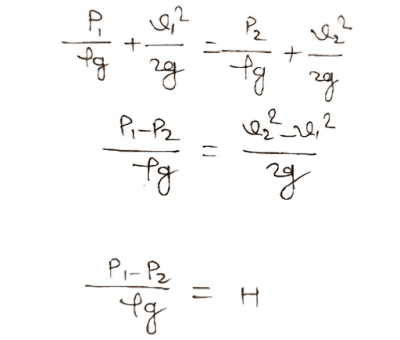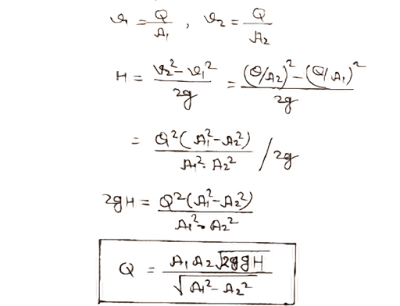It is a device (Venturimeter) with the help of which the rate of flow of liquid in a pipe can be determined at any point. With its help, discharge can be measured in horizontal, vertical, and inclined pipes.
Cover in this post or notes construction, working Principle, derivation advantages and disadvantages of venturi meter.
{tocify} $title={Table of Contents}
Construction
The Venturimeter device mainly consists of three parts.
i. Convergent section
ii. Throat
iii. Divergent section
Convergent, the larger diameter end of the conical pipe is connected to the main pipeline (whose diameter is D) and connects the smaller diameter end to the throat of the same diameter. The length of the convergent pipe is 2.5 D. The length of the throat should not be less than D/2 and the diameter should not be less than D/3.
The end of the throat joins with the divergent pipe to form the whole structure, the whole structure by joining the divergent pipe and the diameter of the big ends of both the divergent pipes is equal to the diameter of the main pipe.
Working Principle
When fluid flows through the venturimeter, its speed increases at the throat after entering the converging tube. Because the diameter of the converging tube decreases and excretion remains constant, hence the pressure on the throat will decrease.
This reduction in pressure enters the venturi meter. Opaque liquid with the help of piezometer drains on the throat can be detected with the help of a pressure gauge.
Derivation
Let the pressure, area, and velocity of the liquid at the inlet and throat of the horizontal venturimeter be P1, A 1, V1, and P2, A 2, V2.
Let is the discharge of the liquid flowing through the venturi meter and the density (ρ) of the liquid.
Then the pressure head at the inlet = P1/ρg
" " " " " Velocity head= V1²/2g
Then the pressure head at the throat = P2/ρg
" " " " " " Velocity head = V2²/2g
Then the form Continuity equation
Q = A1 V1 = A2 V2 .............(1)
Taking the center line of the venturi meter as the basis, entrance, and throat per Bernoulli's theorem
Form equation (1)
This equation has been derived by neglecting the frictional losses in the venturimeter. But in reality, the difference in pressure head for discharge will be more than H so that the calculated discharge will be greater than the actual discharge.
To overcome this error, a constant C is used which is denoted by the coefficient of discharge (Cd).
Limitation of Venturi meter
(1) The liquid should flow completely through the venturimeter.
(2) The flow of fluid in the venturimeter must be incompressible.
(3) The pressure at the throat is greater than the vapor pressure of the liquid.
(4) When the pressure at the throat is less than the vapor pressure of the liquid, the flowing liquid evaporates.
(5) The greater the ratio between the diameters of the mouth and throat of the venturimeter, the lower the pressure will be at the throat. The ratio of diameters is kept from 2:1 to 1:1.
Advantages of Venturi meter
Irrespective of the position in which the venturimeter is placed, the pressure difference remains the same in both inclined and vertical positions.
Disadvantage of Venturi meter
The more space the venturi meter occupies in the pipe, the higher its value.




